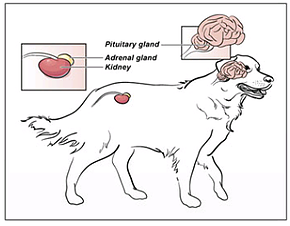 The adrenal glands are a pair of small glands located just in front of the kidneys. They make cortisol (a corticosteroid hormone), which helps the body adapt to stress. Cortisol helps the body prepare for a “fight or flight response” by preparing the body’s resources (such as fat, sugar, and water stores) for rapid breakdown in a stressful situation. However, long-term excesses of cortisol are harmful to your pet. Too much production of cortisol is called “Cushing’s disease” or hyperadrenocorticism. The opposite of this endocrine disorder is called hypoadrenocorticism or Addison’s disease, a condition that results in too little cortisol production from the adrenal glands.
The adrenal glands are a pair of small glands located just in front of the kidneys. They make cortisol (a corticosteroid hormone), which helps the body adapt to stress. Cortisol helps the body prepare for a “fight or flight response” by preparing the body’s resources (such as fat, sugar, and water stores) for rapid breakdown in a stressful situation. However, long-term excesses of cortisol are harmful to your pet. Too much production of cortisol is called “Cushing’s disease” or hyperadrenocorticism. The opposite of this endocrine disorder is called hypoadrenocorticism or Addison’s disease, a condition that results in too little cortisol production from the adrenal glands.
Types of Cushing’s Disease:
PDH (Pituitary Dependent Hyperadrenocorticism (85% of cases): PDH is caused by the pituitary gland in the brain sending too much signal for the adrenal glands to produce cortisol. This is a benign, yet functional tumor of the pituitary gland.
Adrenal Tumors (15 % of cases): Adrenal tumors can cause too much cortisol production, and can be benign or malignant.
Symptoms of Cushing’s Disease:
Many times the symptoms progress gradually and can be mistaken for the normal aging process. Animals may not have all of these symptoms.
- Drinking excessively, urinating excessively, urinary incontinence
- Increased appetite
- Pot-bellied appearance
- Muscle weakness (lethargy, reluctance to jump)
- Skin Disease
- Hair loss on body (not head or limbs)
- Thin skin, poor wound healing
- Hair not growing back after clipping
- Darkening of skin
- Persistent or recurrent skin infection
- Excessive panting
Testing for Cushing’s Disease:
Medical Workup (chemistry panel, complete blood count, and urinalysis with bacterial culture): we can be suspicious of Cushing’s disease based on the results of this workup.
LDDS (Low Dose Dexamethasone Suppression Test): the most common screening test for Cushing’s disease.
- Blood samples are drawn right after a small dose of Dexamethasone is administered, then again at 4 hours and 8 hours later.
- The pet stays in the hospital for the day (9 hours) for this test.
- This test cannot be done at the same time as a surgery, sedation, or general anesthesia.
ACTH Stimulation Test: usually done to monitor effectiveness of treatment.
- Blood sample is drawn initially, then one hour after the administration of ACTH.
- The pet needs to stay in the hospital for about 2 hours.
Abdominal ultrasound: used to assess adrenal glands for abnormalities- this can be done during the hospital stay for the LLDS test.
Treatment:
Most often, treatment for Cushing’s disease involves giving an oral medication indefinitely. However, Cushing’s disease caused by an adrenal tumor is usually treated with surgical removal of the tumor.
Trilostane
Trilostane is an inhibitor of an enzyme involved in the production of several steroids made in the body, including cortisol. Inhibiting this enzyme decreases the production of cortisol.
- Trilostane is given once or twice a day with food.
- Common side effects are mild lethargy and appetite reduction especially when medication is started and the body adapts to its hormonal changes.
- Addisonian reactions have been reported in which the adrenal cortex dies off. Most reactions are minor and can be reversed with discontinuation of trilostane; however, permanent Addisonian reactions are rare, just as with Lysodren. In two studies, the risk of a permanent or life-threatening Addisonian reaction was 2-3% with trilostane and 2-5% with Lysodren.
- ACTH stimulation testing needs to be performed 10, 30 and 90 days after start of treatment and 30 days after each dose adjustment- always 4-6 hours post pill.
Mitotane
- Mitotane (Lysodren) is a drug used to treat Cushing’s disease because it actually destroys some of the cells of the adrenal gland to reduce the amount of cortisol produced. Every animal responds differently to the drug, so careful monitoring is necessary to determine the right dose for each pet. The treatment starts with induction, and then a maintenance dose is usually given for the rest of the pet’s life.
- Induction: Mitotane is given orally at home for approximately 7-10 days, or until signs of lower cortisol levels develop. Then an ACTH Stimulation test is performed to evaluate the adrenal function.
- Maintenance: If the ACTH stimulation test shows that enough Mitotane has been given, a maintenance dose is started (usually given twice a week).

